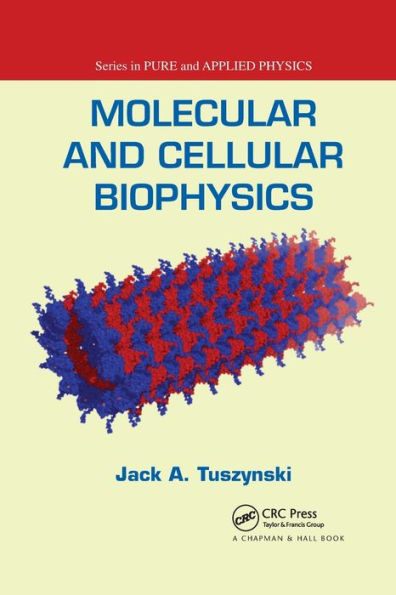Molecular and Cellular Biophysics / Edition 1 available in Hardcover, Paperback, eBook

Molecular and Cellular Biophysics / Edition 1
- ISBN-10:
- 0367388480
- ISBN-13:
- 9780367388485
- Pub. Date:
- 09/23/2019
- Publisher:
- Taylor & Francis
- ISBN-10:
- 0367388480
- ISBN-13:
- 9780367388485
- Pub. Date:
- 09/23/2019
- Publisher:
- Taylor & Francis

Molecular and Cellular Biophysics / Edition 1
Buy New
$82.99Overview
Logically organized from small-scale (molecular) to large-scale (cellular) systems, the text first defines life, discussing the scientific controversies between mechanists and vitalists, the characteristics of living things, and the evolution of life. It then delves into molecular structures, including nucleic acids, DNA, RNA, interatomic interactions, and hydrogen bonds. After looking at these smaller systems, the author probes the larger cellular structures. He examines the cytoplasm, the cytoskeleton, chromosomes, mitochondria, motor proteins, and more. The book concludes with discussions on biophysical processes, including oxidative phosphorylation, diffusion, bioenergetics, conformational transitions in proteins, vesicle transport, subcellular structure formation, and cell division.

Product Details
| ISBN-13: | 9780367388485 |
|---|---|
| Publisher: | Taylor & Francis |
| Publication date: | 09/23/2019 |
| Pages: | 540 |
| Product dimensions: | 6.12(w) x 9.19(h) x (d) |
Table of Contents
1 What Is Life? 1
1.1 Hierarchical Organization of Knowledge 1
1.2 General Characteristics of Living Systems 5
1.3 Artificial Life 7
1.4 Biological Information, Information Processing and Signalling 17
1.5 Origin of Life 23
1.6 Emergence, Intelligence and Consciousness 47
2 What Are the Molecules of Life? 61
2.1 Nucleic Acids, DNA, RNA 61
2.1.1 Chemical Bonds and Bond Energies 65
2.2 Generalized Ester Bonds 65
2.3 Directionality of Chemical Bonds 69
2.4 Types of Inter-Atomic Interactions 80
2.4.1 Ionic Interactions 80
2.4.2 Covalent Bonds 83
2.4.3 Free Radicals 86
2.4.4 Van der Waals Forces 86
2.5 The Hydrogen Bonds and Hydrophobic Interactions 92
2.5.1 Polysaccharides 100
2.6 Amphipatic Molecules in Water Environments 101
2.6.1 Fatty Acids 103
2.6.2 Lipids 105
2.7 Structure of Proteins 105
2.7.1 The Polypeptide Chains 110
2.7.2 Proteins 112
2.7.3 The Process of Protein Folding 120
2.7.4 Electrophoresis of Proteins 124
2.7.5 Protein Interaction with Environment 125
2.7.6 Electron Transfer in Proteins 126
2.8 Structure of Nucleic Acids 127
2.8.1 The Electrostatic Potential of DNA 133
2.8.2 DNA: Information and Damage 134
2.8.3 Fluorescence in Biomolecules 136
3 What Is a Biological Cell? 151
3.1 Cytoplasm 151
3.1.1 Osmotic Pressure of Cells 152
3.1.2 Osmotic Work 153
3.2 Cytoskeleton 154
3.2.1 The Cytoskeleton 154
3.2.2 Biopolymers of the Cytoskeleton 156
3.2.3 Tubulin 157
3.2.4 Microtubules 161
3.2.5 Actin Filaments 166
3.2.6 Actin Binding Proteins 170
3.2.7 Intermediate Filaments 171
3.3 Tubulin Isotype Homology Modelling 173
3.3.1 Solvent Accessible Surface Area 177
3.3.2 Net Charge 177
3.3.3 Dipole Moment Estimation 178
3.3.4 Human Repeats and Dipole-Dipole Interactions 178
3.3.5 Motor Proteins 185
3.4 Anisotropic Elastic Properties of Microtubules 188
3.5 Centrioles, Basal Bodies, Cilia and Flagella 197
3.6 Networks and Meshworks of Protein Filaments, Stress Fibers and Tensegrity 201
3.7 Cell Nucleus and Chromosomes 203
3.7.1 Nuclear Chromatin, Chromosomes, Nuclear Lamina 203
3.7.2 Chromatin/Chromosomes 204
3.8 Mitochondria and Proton Pumps: Energy Generation and Utilization in the Cell 206
3.8.1 Cell Energetics: Chloroplasts and Mitochondria 206
3.8.2 The Cell as a Machine 208
3.8.3 Active Transport 209
3.8.4 Ion Channels and Ion Pumps 210
3.9 Cytochrome Oxidase Enzymes 212
3.9.1 Introduction 212
3.9.2 The Biochemical Structure and Function of the Cytochromes 213
3.9.3 A Simplified Model Calculation 218
3.9.4 A Proposed Mechanism 221
3.10 Membranes and Vesicles 224
3.11 Motor Proteins and Their Role in Cellular Processes 233
3.11.1 Myosin 236
3.11.2 Kinesin Family 239
3.11.3 Ned Dimer Structure 241
3.11.4 Dynein 242
3.11.5 Myosin V 243
3.11.6 Myosin VI 249
3.12 Directed Binding as a Model of Kinesin Walk 250
3.12.1 Chemical Reaction-based Models 256
3.12.2 Mechanically Based Models 258
3.12.3 Models with Alternating Chemical and Mechanical Transformations 259
3.13 Other Structures 268
3.14 Large Polar Molecules 269
3.14.1 Bioferroelectricity 269
4 What Are Life Processes? 307
4.1 Oxidative Phosphorylation 307
4.1.1 The Biochemical Energy Currency- The ATP Molecule 308
4.2 Diffusion Processes 313
4.2.1 Translational Diffusion 314
4.2.2 Diffusional Flow Across Membranes 318
4.3 Proton Transport and Bioenergetics 329
4.3.1 Proton Transport 329
4.3.2 Bioenergetics: The Davydov Model 329
4.4 Electronic and Ionic Conductivities of Microtubules and Actin Filaments 335
4.4.1 The Neuron 336
4.4.2 The Cytoskeleton 340
4.4.3 Overview of Biological Conductivity 342
4.4.4 Intrinsic Electronic Conductivity of Microtubules 345
4.4.5 Actin Filaments Support Non-linear Ionic Waves 368
4.4.6 Long-range Spatio-temporal Ionic Waves along Microtubules 373
4.4.7 Dendritic Cytoskeleton Information Processing Model 378
4.4.8 The Inter-relation Between the Neural Cytoskeleton and the Membrane 381
4.4.9 Relationship to Cognitive Functions 382
4.4.10 The Potential for Bioelectronic Applications and Neuromorphic Computing 385
4.4.11 Discussion 387
4.5 Mechanisms of Exciton Energy Transfer in Scheibe Aggregates 389
4.5.1 The Exciton Model 390
4.5.2 Exciton Domain Size 393
4.5.3 Random Walk Model 395
4.5.4 Phonons 397
4.5.5 Exciton-Phonon Coupling 398
4.5.6 The Role of Non-linearity 399
4.5.7 Conclusions 400
4.6 Conformational Transitions in Proteins 403
4.6.1 The Protein-glass Model 406
4.6.2 The Protein-machine Model 407
4.7 Vesicle Transport and Molecular Motors 409
4.7.1 Chemo-Chemical Machines 409
4.7.2 Biological Machines as Biased Maxwell's Demons 413
4.7.3 Pumps and Motors as Chemo-chemical Machines 415
4.8 Muscle Contraction 420
4.8.1 Biophysics of Muscles 420
4.8.2 Biophysical Mechanisms, Contractile Proteins 424
4.9 Subcellular Structure Formation 428
4.9.1 Aspects of Polymerization of Microtubules 428
4.9.2 Simple Models of Microtubule Assembly 430
4.9.3 Developing a Stochastic Model 435
4.9.4 A Stochastic Model Without Rescues 436
4.9.5 The Averaged Picture; Master Equations 438
4.9.6 Stochastic Models with Rescues 440
4.9.7 A Model with a Finite Collapse Velocity 442
4.9.8 Conditions for Stationary Bell-Shaped Distributions 443
4.9.9 Coherence Effects 445
4.9.10 Summary and Conclusions 447
4.9.11 Assembly of Actin Filaments 448
4.10 Cell Division 453
4.10.1 Cell Division 453
Glossary 481
Index 499
